|
07:49.95S 151:16.96E
Yamdena, Indonesia
Monday 30th
August 2010
The Sail Indonesia Rally
had been here last year, but other than getting the waypoint for the island from
friends, we did not manage to gather a great deal more information, other
than that we could only get our quarantine clearance here, and that a lot of
mini buses collected the people from the rally to visit nearby villages and
have a dancing spectacle put on for them.
However, when we obtained
our Indonesian Cruising Permit (CAIT) from the Indonesian Embassy in Port
Moresby, I was able to photograph the map of Indonesia on the wall, and blow
up the map of this island, to give us a better idea of how ‘civilised’
it might be.
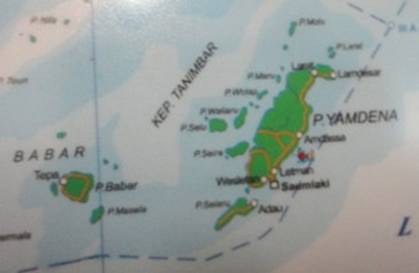
At 6a.m. Monday morning, we
were jerked awake by people yelling at us as they motored past in their noisy
two stroke engined boat! Maybe we’re in the way, being anchored so
close to the oil terminal jetty. But no, all seemed OK. Sipping our tea
enjoying the calm anchorage and having had a good night’s sleep after a
6 day passage, we realised there was a sailing catamaran anchored closer to
the main town of Saumlaki. They had already gone by the time we had pulled
ourselves together, so any information we could gather from them was not to
be had! We motored over to the place they seemed to have been anchored,
which was another large wharf with an inter-island Ro-Ro ferry on the end.
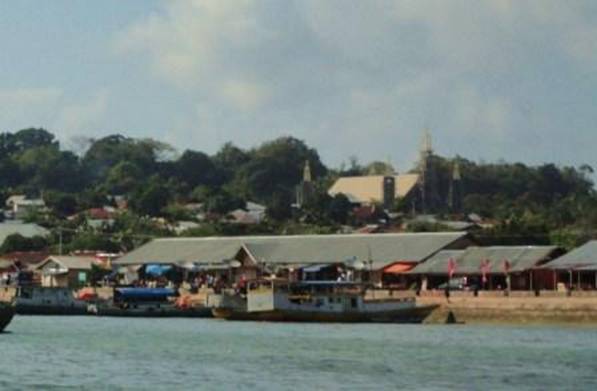
The fishing wharf was full
of boats unloading their catch, in this picture you can see the large Church
just behind, so at least we could see it was a Christian Island, but no
place for us to land our dinghy.
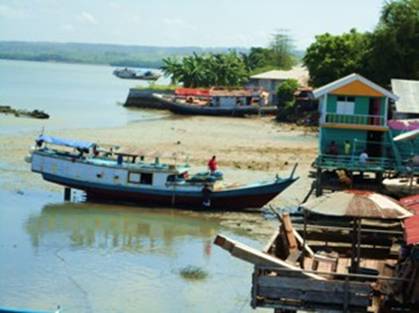
Unless it was into
somebody’s house or boat!
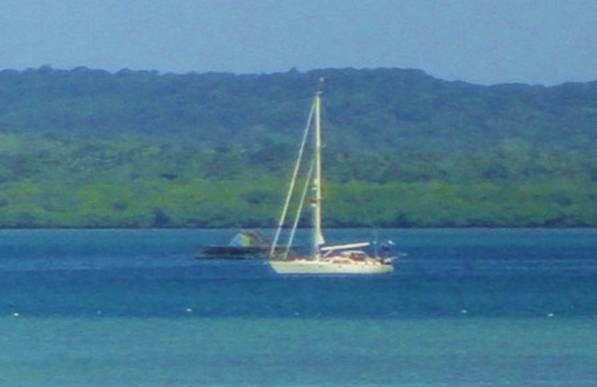
People could see we had
come off the only yacht anchored in the harbour and gesticulated to the
opposite side, so we followed the direction to where the people on shore were
pointing.
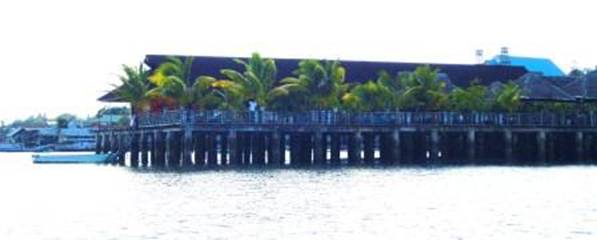
This is the hotel wharf
with steps down, an easier access to shore for us.
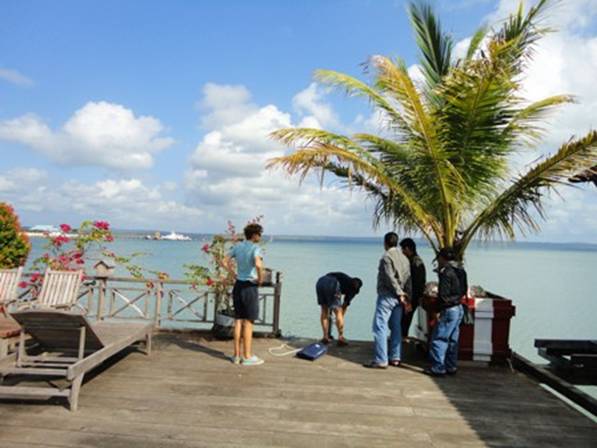
The guys watching us did
not speak English, but showed us to go through to the hotel reception for
information.
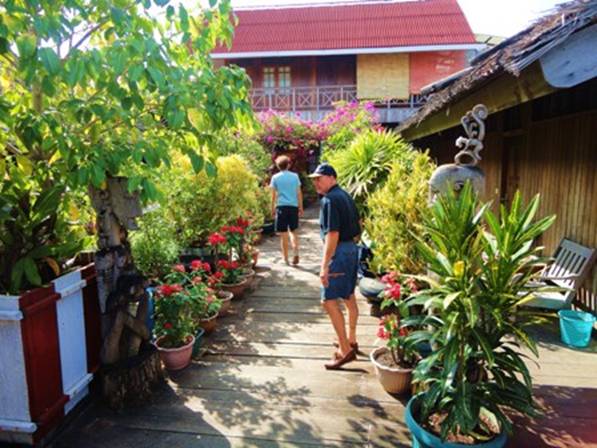 A lovely sight to see such a beautiful entrance from
the wharf, with potted plants and trees decorating the deck, even herbs and
vegetables growing in pots. The Receptionist soon showed us where to find
the Bank, as we had not been able to obtain any Indonesian Rupiah whilst in
Port Moresby. However the ATM at the bank was not in operation that day, so
we decided to change just a few Australian Dollars at the store next door, with
a Chinese lady who was in charge. Not too bad a rate, so it was not a
problem. Whilst looking for a SIM card for our telephone, a young man
approached me and spoke in excellent English. He introduced himself to us as
Higi, the guy who helped the Indonesian Rally organise the events for last
year, so we were in business! A lovely sight to see such a beautiful entrance from
the wharf, with potted plants and trees decorating the deck, even herbs and
vegetables growing in pots. The Receptionist soon showed us where to find
the Bank, as we had not been able to obtain any Indonesian Rupiah whilst in
Port Moresby. However the ATM at the bank was not in operation that day, so
we decided to change just a few Australian Dollars at the store next door, with
a Chinese lady who was in charge. Not too bad a rate, so it was not a
problem. Whilst looking for a SIM card for our telephone, a young man
approached me and spoke in excellent English. He introduced himself to us as
Higi, the guy who helped the Indonesian Rally organise the events for last
year, so we were in business!
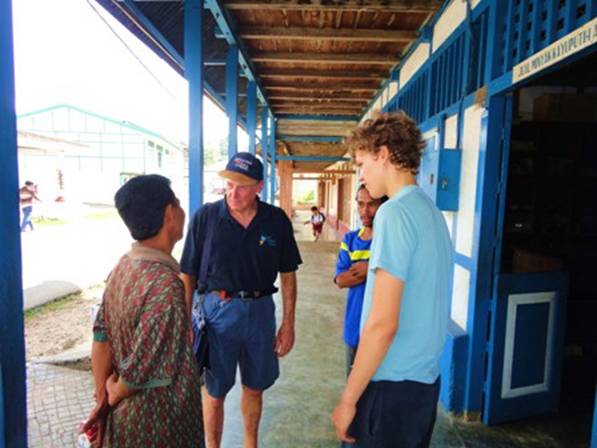 He was able to take us straight to the Port
Captain’s office, where we made an appointment for the Quarantine
officer to come and see us personally on our boat at 2p.m. He was able to take us straight to the Port
Captain’s office, where we made an appointment for the Quarantine
officer to come and see us personally on our boat at 2p.m.
It was a bit of a shock
being in such a busy, bustling town after Port Moresby.
This is truly ASIAN style
– mopeds, minibuses, the street so busy it was hard to cross the road
without being knocked over! Port Moresby virtually had no mopeds, and hardly
any street trading by comparison, only bettle nut traders!
Here are Ollie’s
comments:
My first impressions of Indonesia are slightly
different from what I expected to see; firstly it is far more developed than I
presumed, with roads in the main town and the majority of people with
motorbikes or mini vans which they ferry people around in. This was a
surprise as the majority of people in Port Moresby where without transport,
that was the capital of PNG where this is just as small town. There is also a
booming market littering the streets, on every corner there is someone
selling something, again completely different from Port Moresby where most
people on the street where selling betel nut, but it doesn’t seem to be
the staple here in Indonesia although I have noticed a few red gums. This is
obviously a very fast developing country as it resembles a giant construction
site, it has still held on to the more traditional aspects integrating them
with the modern. This was great, as we were able to get the buzz of the city
but the culture of the past, looking at traditional cloth, and carving and of
course the drink, which is made from fermented coconut flower sap and is
incredibly strong, called Sopi. We have been told and read that Indonesia is
home to the world largest Muslim community, contrary to this are guide Higgi
(a local man who has given us a good look at the surface of Indonesia) told
us that in Yamdema the population is 99% Christian, but we could still hear the
echoes of the Muslims prayers blasting out on speakers, so loudly we could
clearly hear them from the boat. We had worked out where the Mosque and
Church where, it seemed they are on opposite sides of the town, this made me
think it almost like Montague and Capulet families battling it out in fair
Yamdena, but we have read that the two religions live in harmony and I
believe this so far but I am sceptical of the statement. I can’t make
my mind up completely on my view or Indonesia as I have hardly seen any of
it yet, but it seems to be very exciting and vibrant country and I look
forward to experiencing more of rich culture, and of course, more Sopi .
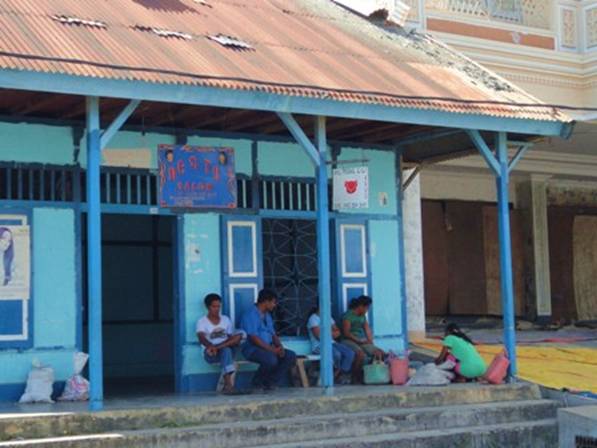
People waiting for a
minibus to take them home after their morning’s shopping
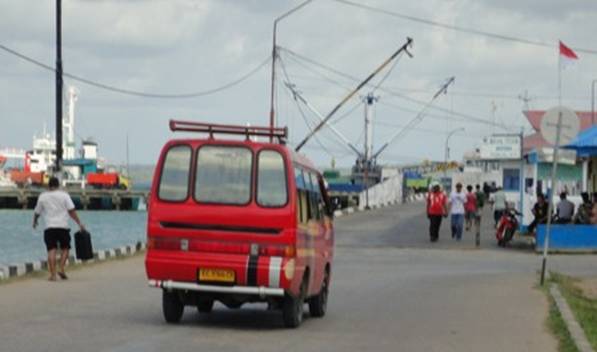
The mini busses’ have a ‘spoiler’
made out of wood on the back? The roads can only be negotiated at 25km an
hour, so maybe it’s to stop them flying in the air when they go over
potholes!
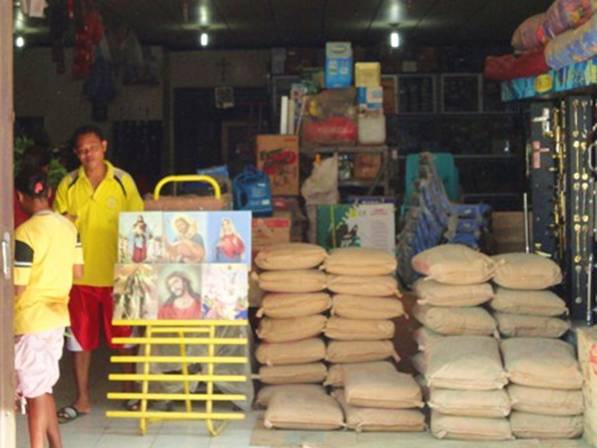
This is the store where we changed the money, this
is definitely a Christian town, with just a few muslims.
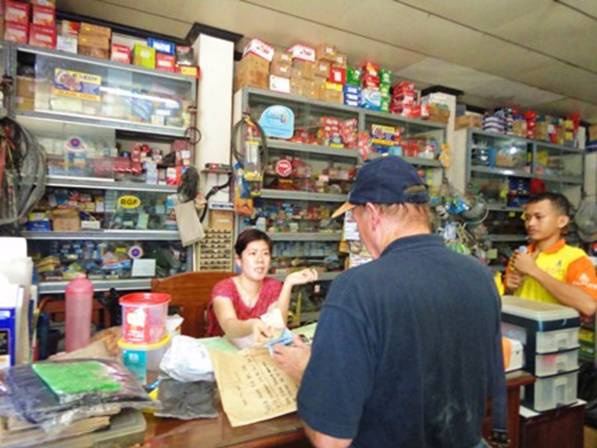
The Chinese lady hands over a wodge of 350,000
Rupiahs for David’s 50$ Australian note!
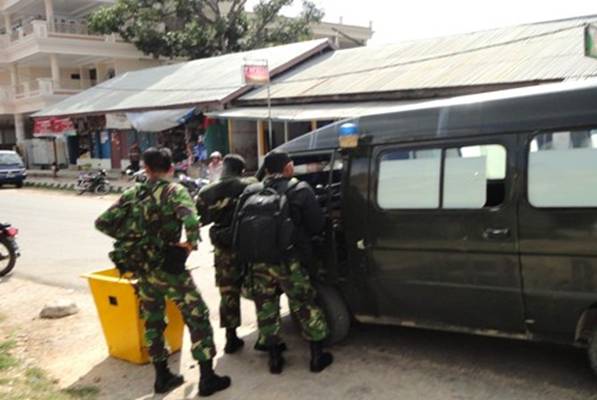
Judging by the size of the island, which appears to
be larger than Phuket, with hardly any roads, I did not pose the question as
to why these army personnel are being mobilised here, I trust they are not going
to dispose of the Christians to introduce more Muslims! Higi told us that
his sister was killed in Ambon when the military fired at a lot of the
Christians demonstrating during the Muslim/Christian conflict there in 2003.
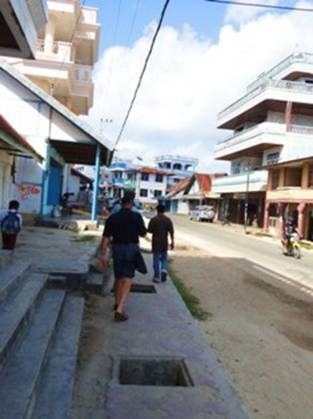
It’s a pity the
Government doesn’t do something about leaving these huge holes in the
middle of the pavement!
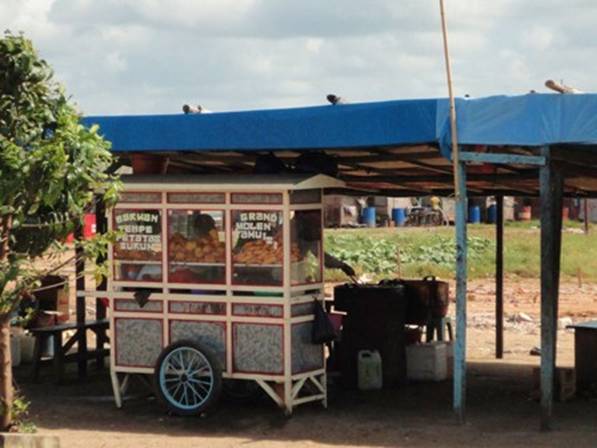
Ollie had not had
breakfast before we left, so this little fast food trolley looked as if it
might offer just the thing to fill an empty stomach
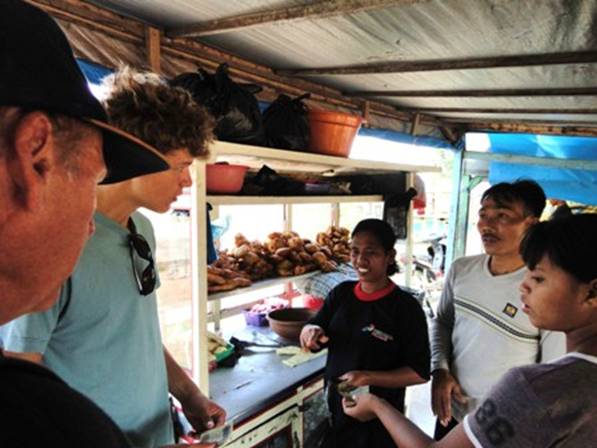
Deep fried battered noodles and chicken tempura
style, and deep fried banana pop overs , tasty!
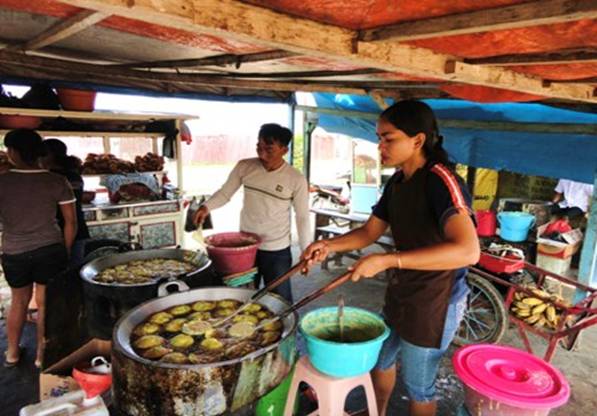
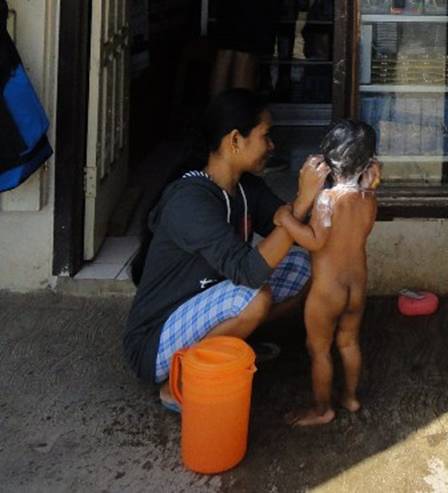
This lady is washing
her child outside her shop – obviously no running water here.
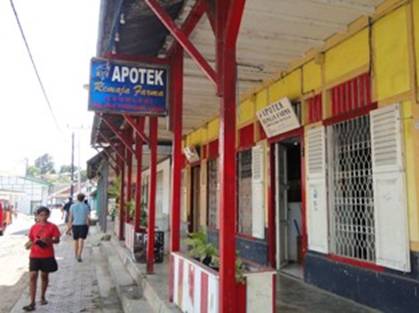
Interesting to see
that the Pharmacy is still holding the Dutch name for it
, APOTEK
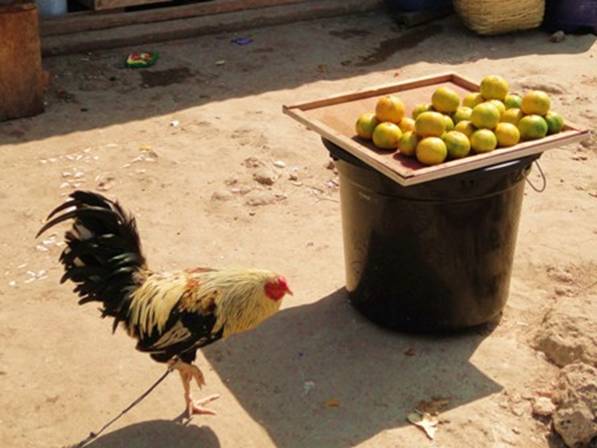
Outside every shop is
a cock held on a tether to something solid. They are used for cock-fighting,
obviously their national pass-time, judging by the kids that offer them up
against each other!
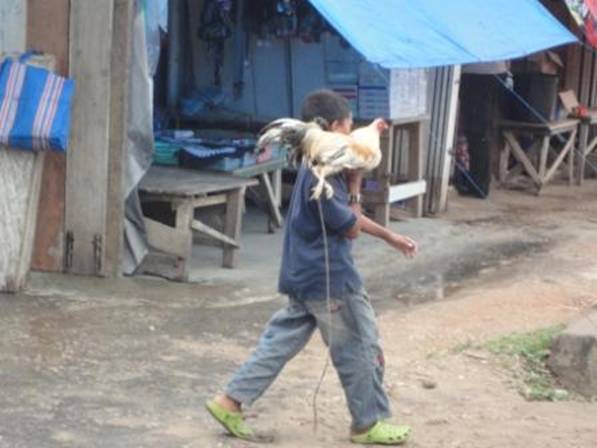
This one is on
it’s way to a Cock fight no doubt!
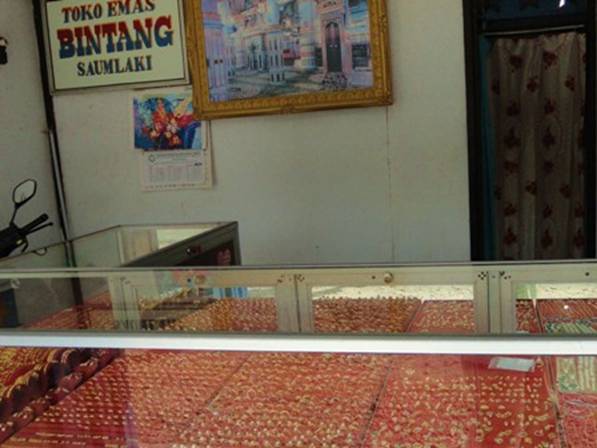
There were plenty of
these small shops selling gold rings, bangles and earrings. Our guide Higi
told us that the man has to offer a lot of these jewellery items to his new
wife when they marry.
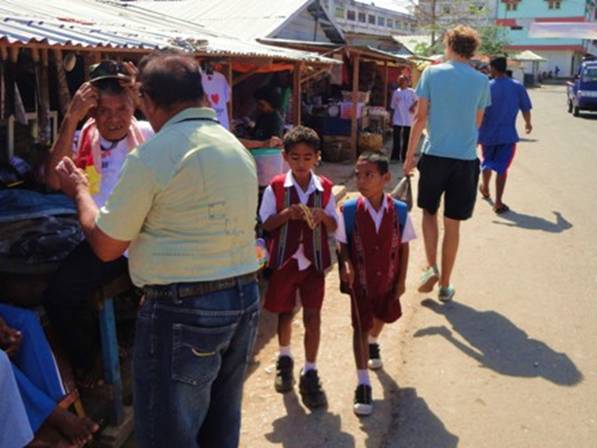
Some of the school
uniforms look very smart, with embroidered strips down their jackets
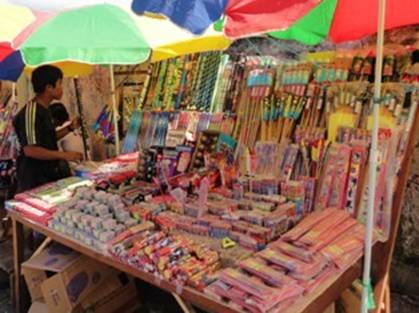
Plenty of fireworks
for sale here, they obviously know how to party, Chinese style!
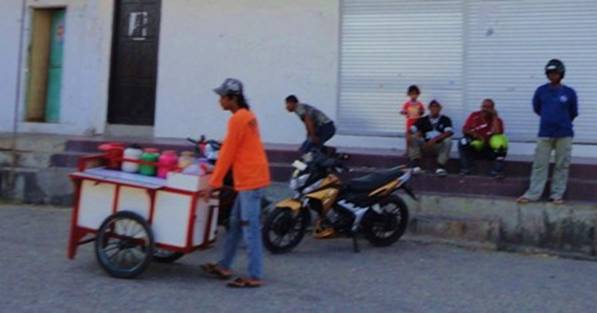
The iced sweet drinks
trolley as seen in so many of the countries we have already visited, being
wheeled to its selling spot.
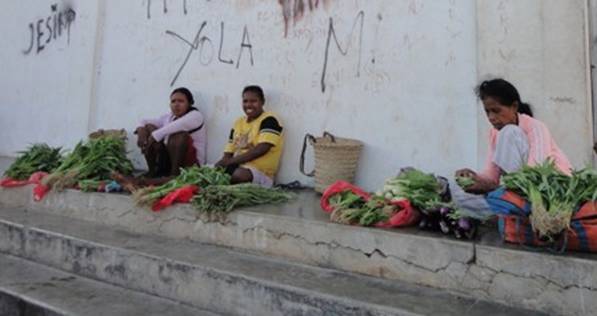
The fruit and veg
market was nearby, but these ladies must come in by bus from the country to
sell their fresh produce, here are the greens, aubergines and beans.
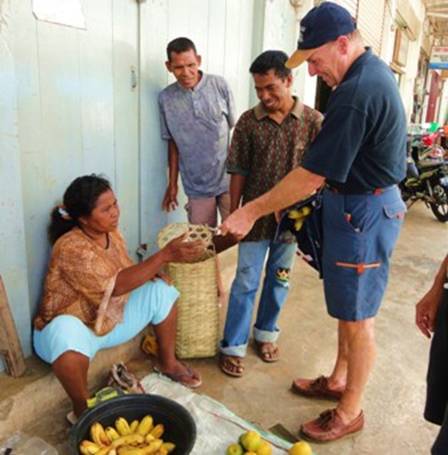
I decide to just buy
some bananas for now, with Higi making sure I pay the right amount, 5,000
Rupiah for a large bunch, which is equivalent to 70cents Australian, or
40pence UK.
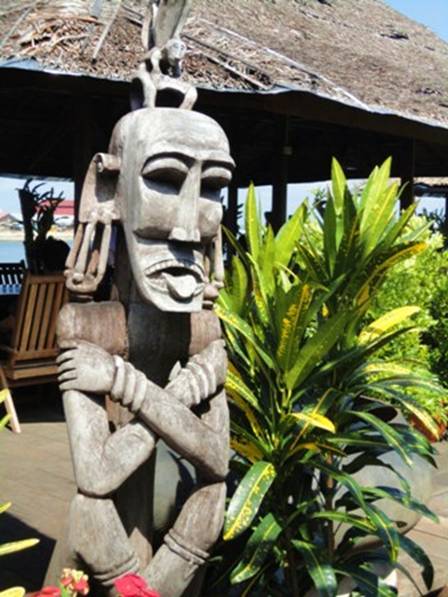
As we make our way
back through the hotel and out onto its’ deck where we left our dinghy,
I cannot help but notice this figure, looks so much like those from Papua New
Guinea, with the tongue sticking out and long earlobes.
Higi offers to take us
on a minibus tour next day to visit the local villages where the women still
weave cloth in the traditional way, and men do carvings.
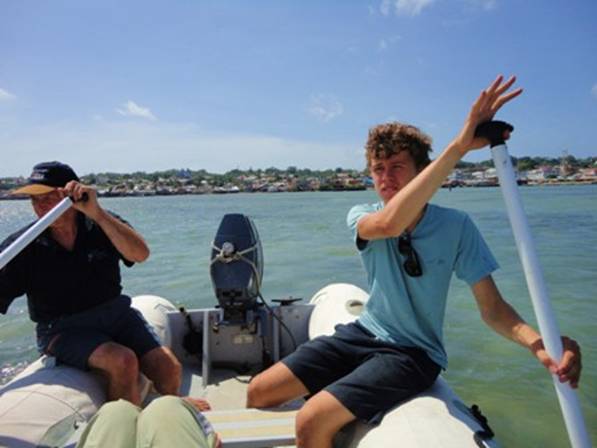
But first David and
Ollie have to paddle away from the wharf, as the tide had gone out!
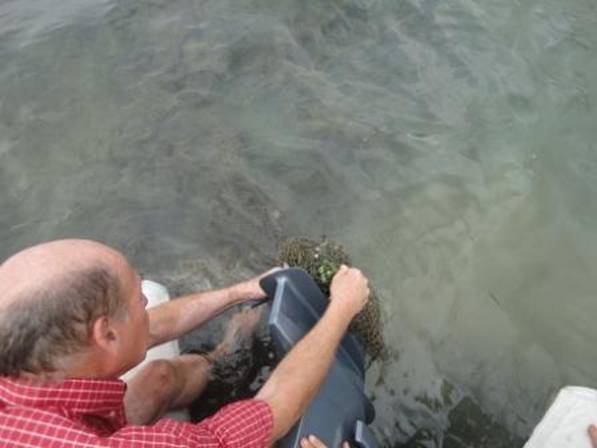
Of course as soon as
we get the engine going, it gets snarled up in sunken fishing nets!
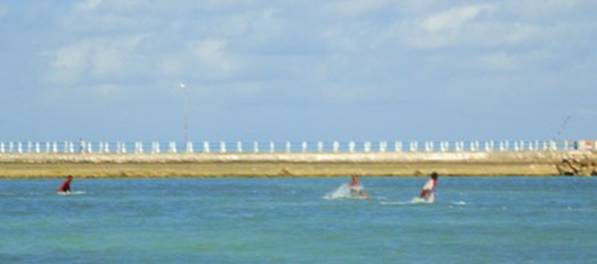
Here are the culprits,
fishermen wading in knee deepwater banging the surface to frighten the fish
into their netting.
After getting all our
washing done and dried, and Ollie had cleaned all the salt off the boat with
a bucket of fresh water, we eventually had the quarantine man visit us at
5.30p.m.
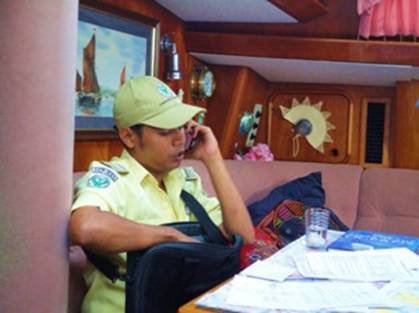
He came on board
Kanaloa with another English speaking man, called Mathias. Our friend Higi
had carefully been side stepped, we learned next morning, as they managed to
overcharge us for their services. They charged us 310,000 Rupiah instead of
210,00 Rupiah, and split the 100,000 (7 pounds, 12 Aus Dollars) between
them! The quarantine man had a good look around the boat, inside large cupboards
and small, checking for illegal castaways that we might be taking over to
Australia, or any illegal drugs.
Higi told us next day
that there were some Iranians who had arrived in Saumlaki recently, having
flown here without their passport, which had been confiscated when they
arrived without a visa in Jakarta. However, this being an internal flight to
Ambon and then Saumlaki, they did not need their passport!
Higi had been asked to
befriend them by the Police, (his uncle is a senior police officer here) to
find out what their reason for visiting Saumlaki was. They eventually opened
up and said that they had arranged for a boat to meet them here and take them
to Australia.
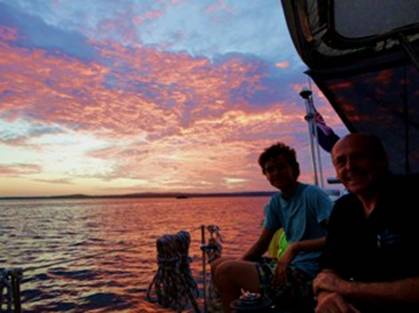
A great sunset to
finish our first day in Indonesia, Ollie had managed to do his watches for
the past 4 nights, and we were relieved to have done the necessary paperwork
to get into Indonesia
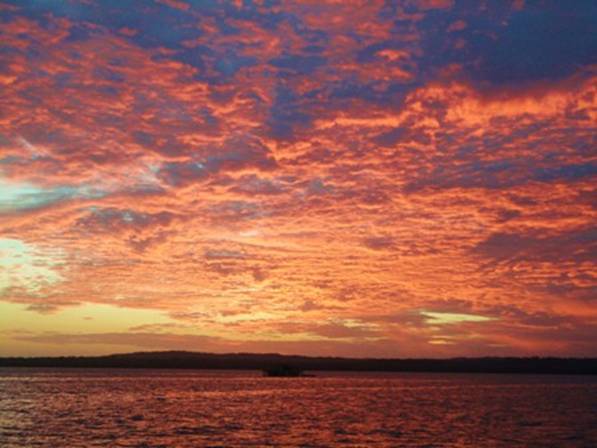
There is a fishing
raft anchored just behind our boat here, in the middle of the photo! This is
where they keep the spawn that grows into larger ‘milk fish’, the
main food source of Asian coastal people.
|

